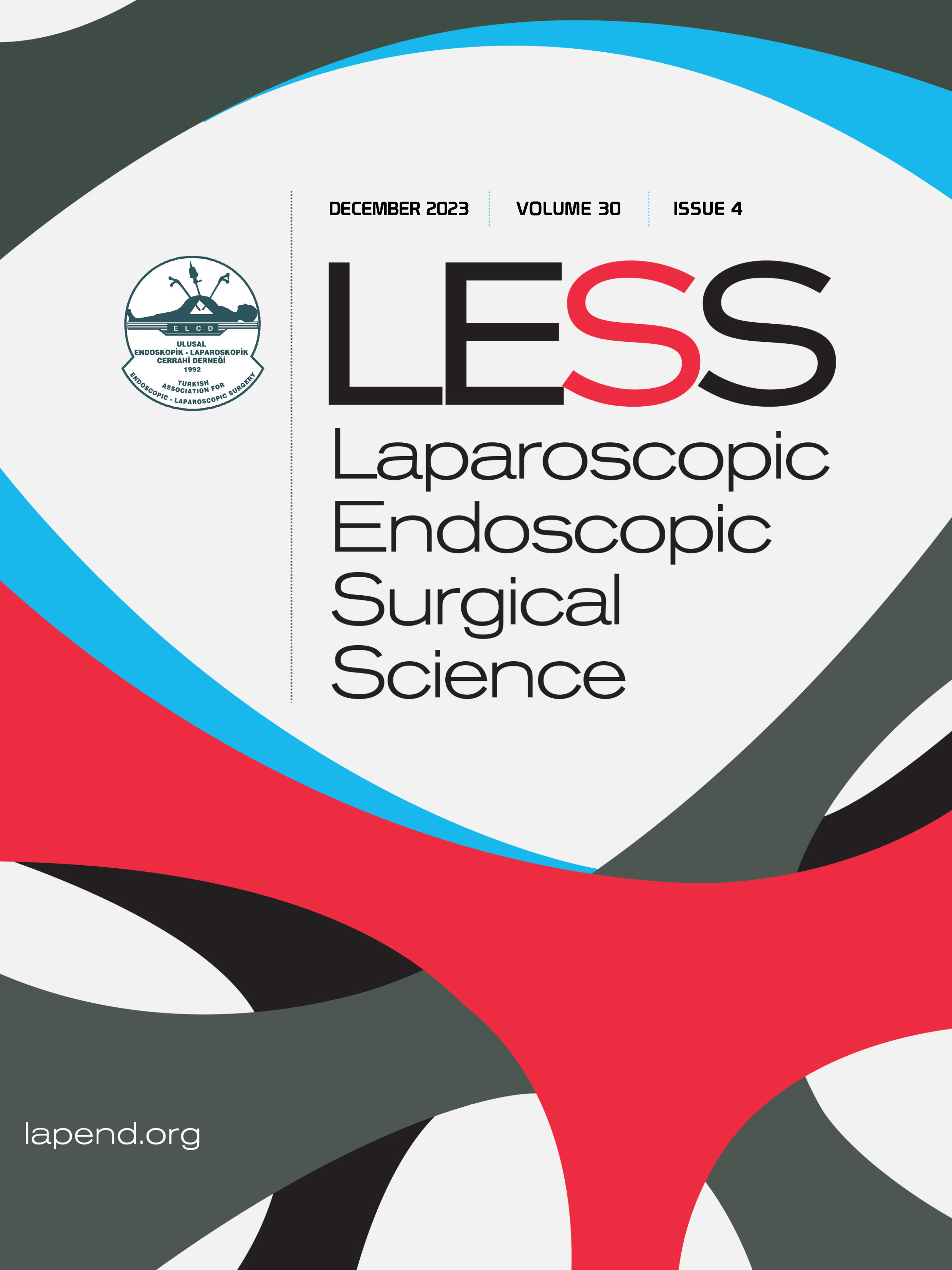Volume: 18 Issue: 4 - 2011
| RESEARCH ARTICLE | |
| 1. | Laparoscopic Gastrectomy in Stomach Cancer: a Single-Center Experience Bahri Çakabay, Salim Demirci, Bülent Aksel, Ekrem Ünal, Sancar Bayar, Hilmi Kocaoğlu, Hikmet Akgül Pages 218 - 222 INTRODUCTION: To evaluate the results of surgical treatment of gastric cancer patients who underwent laparoscopic gastrectomy. METHODS: Two of them are early stomach cancer (T1) and 1 of them is GIST totaly 9 stomach cancer patient who had laparascopic gastrectomy are evaluated in terms of demographic characteristics, time of surgery, quantity of bleeding and peroperative-postoperative complications. The patient data which were collected prospectively were reviewed retrospectively. RESULTS: The patients consisted of 3 females and 2 males. The avarage age was 55. The laparoscopic gastrectomy procedure have been completed in all patients. Because of anastomic line bleeding, one patient was operated on again in postoperative 1. day. The avarage operative time was 3 hours 25 minutes (3.15-4.10). The average postoperative hospital stay was 5.3 days (4-8). And the average intraoperative blood loss was 400 cc. DISCUSSION AND CONCLUSION: Although the operation time was longer than open surgery; the patients with less postoperative pain, less blood loss, early recovery and early discharge observed. Considering these datas and the literature results; we believe that the laparoscopic methods need to be evaluated as an option in the surgical treatment of gastric cancer. |
| 2. | The Relationship Between Postoperative Pain and Dressing Size After Laparoscopic Cholecystectomy Yasin Sönmez, Atilla Kurt, Ali Kaan Gökakın, Ayhan Koyuncu, Ömer Topçu, Cengiz Aydın Pages 223 - 229 INTRODUCTION: This study designed to evaluate the effect of the dressing size on the pain control after laparoscopic cholecystectomy. METHODS: This study included 60 patients who had laparoscopic cholecystectomy operation in our clinic between 2008-2010. They randomized to the two different groups. One group got dressed small dressings; the other group had large dressings after surgery. Visual analog scale (VAS) scores of both groups at 2nd, 4th, 6th, 8th, 12th, 16th, 20th, 24th hours after surgery were documented. RESULTS: When VAS scores of both groups compared, the results revealed that the patients who had small size dressings experienced less pain than the patients who had large dressings (p <0.05). There was also statistically significant difference between two groups in terms of morphine requirement (p <0.05) which was totally 12.49 mg in small dressing group and was 21.28 mg in large dressing group. DISCUSSION AND CONCLUSION: For the patients who had laparoscopic cholecystectomy operation, small size dressings provided more favorable postoperative pain control when compared to the large dressings. |
| 3. | Laparoscopic Donor Nephrectomy: Our Early Results Mehmet Erikoğlu, Tevfik Küçükkartallar, Bayram Çolak, Ahmet Tekin Pages 230 - 235 INTRODUCTION: The increase in the number of patients waiting for organ transplants all around the world and the insufficient number of cadavers, has led to increased interest in transplants from live donors. For volunteer donors, the traditional open donor nephrectomy causes a long scar after the flank incision on the thoraco-abdominal wall, severe pain, risk of pleural injury, incisional hernia, long-term hospital stay, wound problems and a relatively long period of recovery. METHODS: In a study of Laparoscopic Donor Nephrectomy (LDN) comprising 11patients (7 female, 4 male) the surgical technique, intraoperative findings, postoperative follow-up and morbidity were evaluated. RESULTS: All patients underwent laparoscopic left nephrectomy with a transperitoneal approach. Due to artery and vein anomalies in one patient, the open procedure was performed. The mean operative time was 121 min (90-140), the mean follow-up was 6.2 months (1-13), the average length of hospitalization was 3.1 days (2-4), and the mean warm ischemia time was 190 sec (100-240). No perioperative complications were observed and none of the patients showed signs postoperative wound infection. DISCUSSION AND CONCLUSION: With increased surgical experience, LDN is a method that might have a lower rate of mortality and morbidity compared to open nephrectomy. We carry the conviction that LDN is the gold standard for living donor nephrectomy. |
| CASE REPORT | |
| 4. | Single Incision Laparoscopic Surgery (SILS) for Total Abdominal Pre-peritoneal (TAPP) Inguinal Hernia Repair: Report of Repair of a Recurrent Hernia Hüseyin Sinan, Sezai Demirbaş, M. Tahir Özer, Muharrem Öztaş, A. Ziya Balta Pages 236 - 239 We wanted to report on SILS for TAPP inguinal hernia repair for a recurrent right inguinal hernia. A single port designed for SILS (Covidien, North Haven, CT, USA) was placed through a vertical trans-umbilical incision. A 5 mm 30°optical device, roticulator endo grasper, endo dissector and endo shears were used during the operation. In order to reinforce the posterior inguinal wall, prolene mesh and tucker for securing the mesh were also used. The operation required 90 minutes, and the SILS for TAPP inguinal hernia repair procedure was completed without complications. The patient was later discharged without further problems. Although there are some difficulties, SILS for TAPP inguinal hernia repair can be safely used in the hands of experienced laparoscopic surgeons. The technique is safe and feasible, yielding impressive cosmetic results. |
| 5. | Single Incision Laparoscopic Cholecystectomy; Our Initial Experience Ismail Yaman, Hayrullah Derici Pages 240 - 244 Most of the surgeons have been attempting to reduce the number and size of ports in laparoscopic surgery to decrease parietal trauma and improve cosmetic results. These efforts are the fundamentals of the natural orifice transluminal endoscopic surgery and single incision laparoscopic surgery. Single incision laparoscopic surgery is a new procedure. Herein we would like to present our first two patients who underwent single-incision laparoscopic cholecystectomy, and review the previous literature. |
| 6. | The treatment of giant ovarian cyst which mimics mesenteric cysts with laparoscopic approach Orhan Veli, Güvenç Diner, Ramazan Davran, Ibrahim Yetim, Dilek Benk Şilfeler, Akın Aydoğan Pages 245 - 248 Mesenteric cyst are rare intraabdominal pathologies when compared with over cysts that are seen more frequently. Ovarian cystic lesions are usually originated from follicul cyst, corpus luteum cyst, endometrium cyst and seras cystadenom. In this case report, we discussed the giant ovarian cyst which mimic mesenteric cyst and treated with laparoscopic approach. The patient was an 18 years old single woman who had an abdominal pain and distension for approximately 1 year period. The physical examination of the patient included abdominal distention and minimal tenderness with deep palpation. Biochemical studies and tumor markers were normal. Abdominal ultrasonography revealed a 23 x 9 cm cystic lesion which located of right side of abdomen. Computerized tomography determined a 23 x 9 cm lesion which was reported to be a mesenteric cyst and excluded ovarian pathology. For diagnostic and curative management, we planned laparoscopic surgery, the procedure revealed that the giant cyst was originated from ovary. After the aspiration of the internal components of the cyst, total excision was performed. Patient was discharged on postoperative day 2. uneventfully. Laparoscopic surgery should be the first step of differential diagnosis and treatment, even the intraabdominal cystic masses are large in size. |















